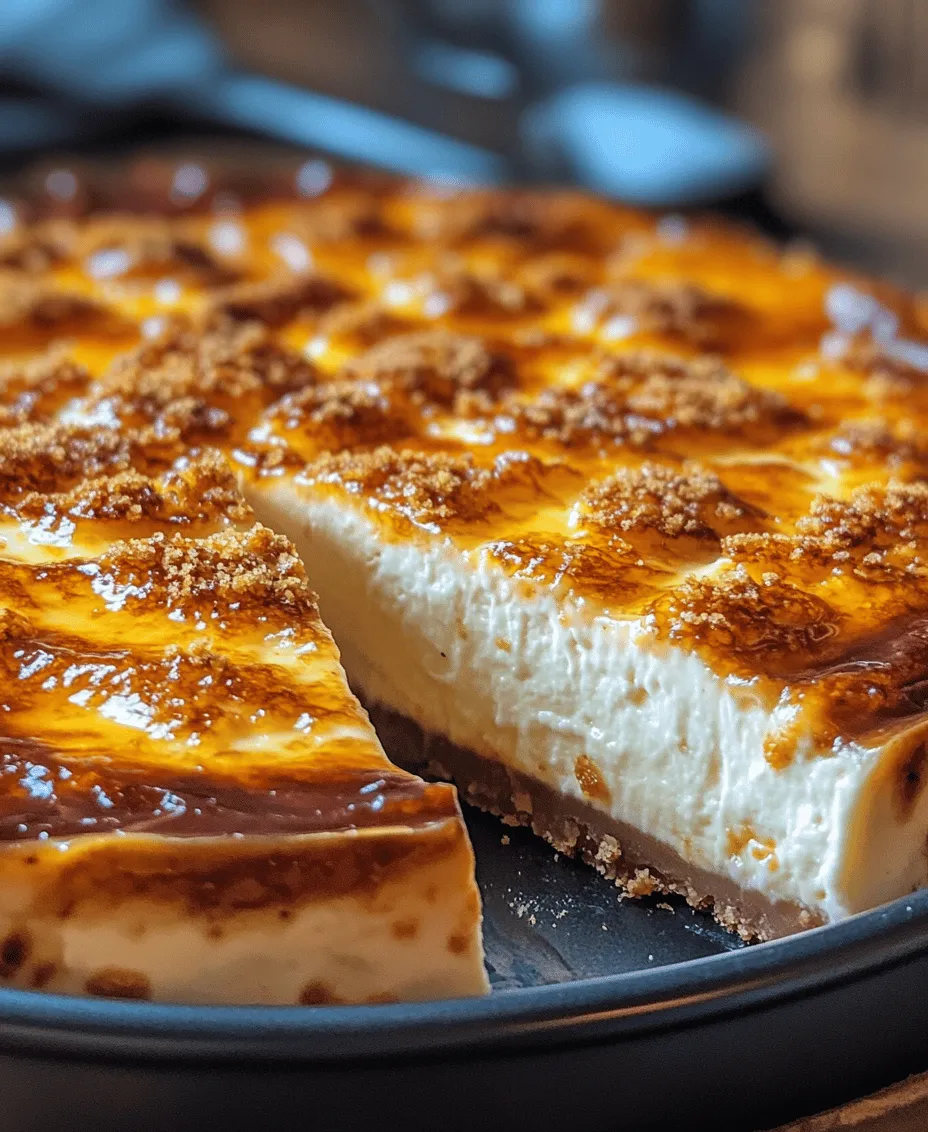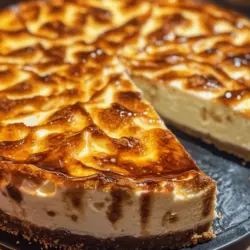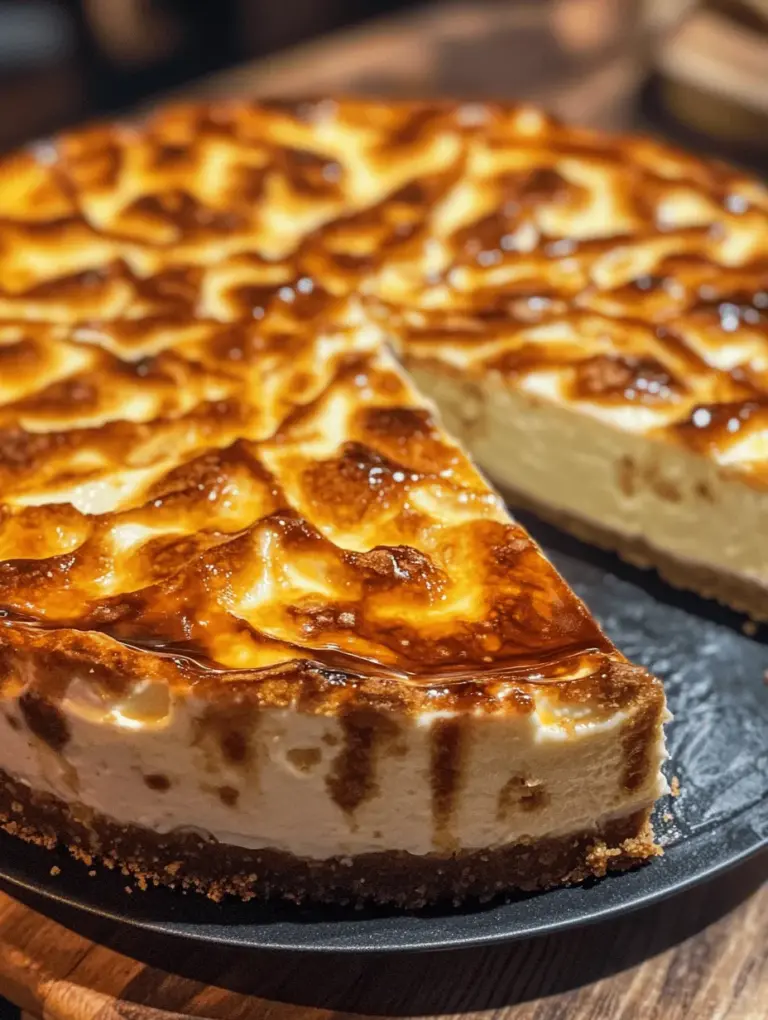Delve into the decadent world of desserts with our Bruléed Cheesecake Delight, a sumptuous treat that combines the creamy richness of cheesecake with a perfectly caramelized sugar crust. This recipe not only satisfies the sweet tooth but also impresses guests with its elegant presentation. Whether you are hosting a dinner party or simply indulging yourself, this cheesecake is sure to be a standout. In this article, we will explore the intricacies of this delightful dessert, ensuring that you can recreate it with ease and expertise.
Understanding Cheesecake: A Brief History
The Origins of Cheesecake
Cheesecake has a rich and fascinating history that dates back thousands of years. Its origins can be traced to ancient Greece, where a simple mixture of cheese, honey, and flour was served to athletes during the first Olympic Games around 776 B.C. This early version of cheesecake was far from the elaborate dessert we know today but laid the groundwork for its evolution over the centuries. The Greeks used a cheese called “laboratory” which was made from sheep’s milk, and it was often flavored with honey, creating a delightful contrast of sweet and savory.
As the Romans expanded their empire, they encountered the Greek cheesecake and began to modify it. They introduced new ingredients such as eggs, which helped to bind the mixture and give it a firmer texture. The Romans are credited with popularizing cheesecake throughout Europe, leading to various regional adaptations that would eventually shape the diverse forms of cheesecake we enjoy today.
Exploring the Evolution of Cheesecake Recipes
With the spread of cheesecake across Europe, different cultures began to put their own spin on the classic dessert. In Italy, the introduction of ricotta cheese resulted in the creation of the famous Italian cheesecake, which has a lighter texture compared to its cream cheese counterpart. Meanwhile, in France, the addition of cream and a more delicate cooking method produced the velvety French cheesecake, known for its airy consistency.
In the United States, cheesecake took on a life of its own, particularly with the introduction of cream cheese in the early 20th century. The first published recipe for American-style cheesecake appeared in a New York City cookbook in 1872, but it wasn’t until the 1920s that cream cheese became widely popular. This led to the creation of the iconic New York-style cheesecake, characterized by its dense and rich texture. Today, variations of cheesecake can be found worldwide, from Japanese cotton cheesecake to no-bake versions, each reflecting the culinary traditions and preferences of its origin.
Cheesecake Around the World
Cheesecake is a beloved dessert that transcends borders, and each culture brings its unique flair to the classic recipe. In Japan, for example, the “Japanese cheesecake” is known for its light and fluffy texture, achieved through the incorporation of whipped egg whites. This delicate dessert has gained popularity worldwide for its melt-in-your-mouth consistency.
In Germany, the “Käsekuchen” features a unique combination of quark cheese and a buttery crust, resulting in a slightly tangy flavor profile. The Germans often add fruit toppings or even chocolate to enhance the dessert’s appeal.
The Brazilian “Torta de Ricota” is another delightful variation, incorporating ricotta cheese and often flavored with tropical fruits, providing a refreshing twist on traditional cheesecake.
As we embark on our journey to create the Bruléed Cheesecake Delight, it’s essential to appreciate the diverse history and evolution of cheesecake, which influences our modern interpretations and innovations in the kitchen.
Ingredient Breakdown
Creating the perfect Bruléed Cheesecake Delight begins with understanding the importance of using high-quality ingredients. Each component plays a vital role in achieving the ideal flavor and texture.
The Importance of Quality Ingredients
When it comes to baking, the quality of your ingredients can make or break your final product. For this cheesecake, it is essential to select the best cream cheese, fresh eggs, and pure vanilla extract. High-quality ingredients not only enhance the flavor but also contribute to the overall texture and appearance of the dessert. Opting for organic or artisanal products can elevate your cheesecake experience, making it richer and more satisfying.
Graham Cracker Crust: A Perfect Base
The foundation of our Bruléed Cheesecake Delight is the graham cracker crust. This crust provides a delightful contrast to the creamy filling and adds a touch of sweetness. When choosing graham crackers, look for those made with whole grains for added flavor and texture. You can also experiment with flavored graham crackers, such as chocolate or cinnamon, to give your crust a unique twist.
Cream Cheese: The Heart of the Cheesecake
Cream cheese is undoubtedly the star of the show in any cheesecake recipe. Its rich and creamy texture forms the base of the filling, providing that signature smoothness we all crave. For the best results, use full-fat cream cheese, which ensures a rich flavor and creamy consistency. Make sure to allow the cream cheese to come to room temperature before mixing, as this will help achieve a lump-free filling.
Sour Cream: Adding Creaminess and Tang
Sour cream is another vital ingredient in our cheesecake recipe. It adds an extra layer of creaminess while also introducing a subtle tang that balances the sweetness of the dessert. The acidity of sour cream enhances the overall flavor profile and contributes to the cheesecake’s velvety texture. If you prefer, you can substitute sour cream with Greek yogurt for a healthier option.
Eggs: Binding and Texture
Eggs play a crucial role in binding the ingredients together and providing structure to the cheesecake. They contribute to the overall texture, making it creamy and smooth. For the best results, use large eggs and allow them to come to room temperature before mixing them into the batter. This will create a better emulsion and prevent a grainy texture in your cheesecake.
Vanilla Extract and Lemon Zest: Flavor Enhancers
To elevate the flavor of your cheesecake, we incorporate pure vanilla extract and fresh lemon zest. Vanilla extract adds depth and warmth, while lemon zest introduces a refreshing brightness that balances the rich flavors of the cream cheese. Together, these ingredients create a harmonious blend that will delight your taste buds.
The Role of Sugar: Balancing Sweetness and Texture
Sugar is essential for sweetness, but it also plays a role in achieving the right texture. Granulated sugar is typically used for the filling, while a sprinkle of sugar on top will create the caramelized crust that defines the “bruléed” aspect of this dessert. Be mindful of the amount of sugar you use, as it should enhance the flavors without overpowering them.
Preparing the Crust
Now that we’ve explored the ingredient breakdown, let’s move on to preparing the crust for our Bruléed Cheesecake Delight. A well-prepared crust sets the stage for the creamy filling, providing a delightful textural contrast.
Choosing the Right Graham Crackers
Selecting the right graham crackers is an essential first step in creating the perfect crust. Look for graham crackers that are not overly sweetened and have a sturdy texture. You can use traditional graham crackers or experiment with flavored varieties for a unique twist. If you’re feeling adventurous, consider making your own graham cracker crumbs by blending whole graham crackers in a food processor until finely ground.
Mixing the Ingredients for Optimal Texture
To prepare the crust, combine the graham cracker crumbs with melted butter and a touch of sugar. The melted butter binds the crumbs together, while the sugar adds a hint of sweetness. Mix the ingredients until they resemble wet sand, ensuring that all the crumbs are evenly coated. If the mixture feels too dry, add a little more melted butter until you achieve the desired consistency.
Pressing the Crust: Getting It Just Right
Once your crust mixture is ready, it’s time to press it into your springform pan. Start by firmly pressing the mixture into the bottom of the pan, making sure it is evenly distributed. Use the back of a measuring cup or a flat-bottomed glass to create a smooth surface. For added stability, you can also press the crust mixture up the sides of the pan, creating a more substantial base for your cheesecake.
Baking the Crust: Key Considerations
Baking the crust is a crucial step that helps set its texture and flavor. Preheat your oven to 350°F (175°C) and bake the crust for about 8-10 minutes or until it turns golden brown. Keep an eye on it to prevent overbaking, as a burnt crust can affect the overall taste of your cheesecake. Once baked, remove the crust from the oven and allow it to cool before adding the cheesecake filling.
Crafting the Filling
With the crust prepared, we can now focus on crafting the filling for our Bruléed Cheesecake Delight. Achieving the perfect filling requires careful attention to the mixing process and an understanding of how each ingredient contributes to the final texture.
Achieving the Perfect Cream Cheese Consistency
To create a smooth and creamy cheesecake filling, start by beating the room-temperature cream cheese in a mixing bowl until it is light and fluffy. This process incorporates air into the cream cheese, which helps create a lighter texture in the final product. Avoid overmixing, as this can lead to a dense filling.
Incorporating the Ingredients: Tips for a Smooth Filling
When adding the remaining ingredients, it’s important to do so gradually. Begin by adding the granulated sugar and mixing until well combined. Then, incorporate the sour cream, eggs, vanilla extract, and lemon zest one at a time, mixing just until combined after each addition. This gradual mixing ensures that the ingredients are fully incorporated without overworking the batter, which can cause the cheesecake to crack during baking.
The Importance of Gradual Mixing
Incorporating the ingredients gradually not only prevents overmixing but also helps maintain a stable structure in the cheesecake. Be mindful of the mixing speed; using a low to medium speed will prevent too much air from being incorporated, which can lead to cracks in the finished cheesecake. Scrape down the sides of the bowl as needed to ensure that all ingredients are evenly mixed.
As we move forward in this culinary journey, the next steps will guide us through the process of baking the cheesecake to perfection and achieving that signature bruléed crust that makes this dessert a true showstopper.

Baking in a Water Bath: Why It Matters
Baking a cheesecake in a water bath, or bain-marie, is a crucial step in achieving a perfectly smooth and creamy texture. This technique helps regulate the cheesecake’s temperature, preventing the edges from cooking faster than the center. Without this method, the cheesecake can develop cracks as it cools, due to the rapid temperature change.
Baking the Cheesecake
Understanding Oven Temperature and Timing
When it comes to baking your Bruléed Cheesecake Delight, preheating your oven to 325°F (160°C) is essential. This moderate temperature allows the cheesecake to bake evenly without browning too quickly. Place your cheesecake in the center of the oven to ensure even heat distribution. The baking time typically ranges from 55 to 70 minutes, depending on the thickness of your cheesecake. It’s important to check it periodically, as every oven can vary slightly in temperature.
Recognizing the Signs of a Perfectly Baked Cheesecake
A perfectly baked cheesecake will appear slightly puffed and may have a gentle jiggle in the center when you shake it. The edges should look set, while the center remains slightly wobbly — this ensures a creamy texture once chilled. Avoid overbaking, as this can lead to a dry cheesecake, which defeats the purpose of this indulgent dessert.
Cooling Techniques: Preventing Cracks and Ensuring Creaminess
Once your cheesecake has finished baking, turn off the oven and crack the door open slightly. This gradual cooling process helps prevent sudden temperature changes that can cause cracks. Allow the cheesecake to cool in the oven for about an hour before transferring it to a wire rack.
After it has cooled to room temperature, cover it with plastic wrap and refrigerate for at least 4 hours, or preferably overnight. This cooling step allows the flavors to meld and the cheesecake to set perfectly.
Chilling for the Perfect Texture
The Science Behind Chilling Cheesecake
Chilling is a critical step in cheesecake preparation. It allows the cheesecake to firm up, ensuring a slice that holds its shape. During this time, the flavors develop, and the creaminess reaches its peak. The chilling process also helps to soften any sharpness from the cream cheese, resulting in a smooth and velvety bite.
Recommended Chilling Times: Why They Matter
For optimal results, aim to chill your cheesecake for a minimum of 4 hours, but overnight is ideal. The longer it chills, the better the texture and flavor will be. If you’re short on time, a minimum of 2 hours can work, but be prepared for a slightly softer filling.
How to Store Your Cheesecake Properly
To store your cheesecake, keep it in the refrigerator, covered tightly with plastic wrap or in an airtight container. This prevents it from absorbing any odors from other foods and maintains its creamy texture. Cheesecake can last in the fridge for about 5 to 7 days. If you want to keep it longer, consider freezing it. Wrap the cheesecake tightly in plastic wrap and aluminum foil and store it in the freezer for up to 3 months. When ready to enjoy, thaw it overnight in the refrigerator.
Brulée Topping: The Finishing Touch
Caramelizing Sugar: Techniques and Tools
The crowning glory of your Bruléed Cheesecake Delight is its caramelized sugar topping. To achieve that perfect bruléed crust, you’ll need granulated sugar and either a kitchen torch or the broiler function of your oven.
Sprinkle an even layer of sugar over the chilled cheesecake, ensuring it covers the surface entirely. For the best results, use superfine sugar, as it melts and caramelizes more evenly than regular granulated sugar.
Using a Kitchen Torch Safely
If you opt for a kitchen torch, hold it about 2 inches above the sugar and move it in a circular motion until the sugar melts and turns a golden amber color. Be mindful of safety; avoid directing the flame toward yourself or anything flammable.
Achieving the Perfect Golden Crust
If you prefer using the broiler, set your oven to broil and place the cheesecake on the top rack. Keep a close eye on it, as sugar can go from perfectly caramelized to burnt very quickly. It usually takes 1 to 3 minutes to achieve that desired golden crust. Once caramelized, allow it to cool for a few minutes before slicing to let the sugar harden slightly.
Serving Suggestions
Plating Your Cheesecake for Maximum Appeal
Presentation is key when serving your Bruléed Cheesecake Delight. Use a sharp, warm knife to cut clean slices. Serve each slice on a dessert plate and consider garnishing with fresh berries, a dollop of whipped cream, or a drizzle of fruit sauce. Creating a beautiful presentation elevates the dining experience and showcases your culinary skills.
Pairing Options: What to Serve with Cheesecake
To complement the rich flavors of your cheesecake, pair it with a variety of accompaniments. Fresh fruit, such as strawberries, raspberries, or blueberries, add a refreshing contrast. A scoop of vanilla ice cream or a dollop of crème fraîche can also enhance the indulgent experience. For a touch of elegance, serve with a glass of dessert wine or a rich coffee.
Creative Presentation Ideas
For an artistic flair, consider arranging the plate with a swipe of berry coulis or chocolate sauce. You can also add edible flowers or a sprinkle of cocoa powder around the plate for a refined touch. Creating height with your garnishes, such as stacking fruits or adding a small pastry element, can also make your dessert visually stunning.
Healthier Alternatives and Variations
Exploring Low-Sugar and Gluten-Free Options
If you want to enjoy the Bruléed Cheesecake Delight with a healthier twist, consider using low-sugar alternatives such as monk fruit sweetener or erythritol. For a gluten-free version, simply substitute traditional graham crackers with gluten-free cookies or almond flour for the crust. These adjustments allow you to enjoy the cheesecake without compromising on flavor.
Alternative Flavors: Infusing Different Ingredients
This cheesecake recipe is versatile; you can easily infuse it with different flavors. Consider adding lemon zest for a citrusy brightness, or swirl in some melted chocolate or peanut butter for a decadent twist. You could even incorporate spices like cinnamon or nutmeg for a warm, spiced flavor profile.
Vegan Cheesecake: A Plant-Based Twist
If you are looking for a vegan option, you can create a delicious plant-based cheesecake by using soaked cashews blended with coconut cream, maple syrup, and vanilla extract as a filling. For the crust, use dates and nuts to achieve the desired texture. After following the same caramelizing process for the brulée topping, you’ll have a delightful vegan dessert that everyone can enjoy.
Conclusion
Indulging in a slice of Bruléed Cheesecake Delight is more than just a dessert; it’s an experience that combines flavors and techniques with a touch of culinary art. By following this detailed guide, you can confidently create a cheesecake that not only tastes incredible but also looks stunning. Embrace the process and enjoy every bite of this exquisite dessert, knowing you’ve mastered the art of cheesecake making. Whether you choose to keep it classic or explore healthier variations, this cheesecake is sure to impress at any gathering, making it a delectable centerpiece for celebrations or a comforting treat for quiet evenings at home.

